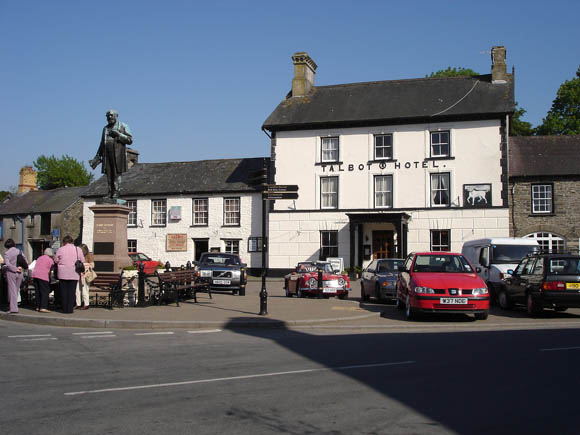Tr�garon (Caron, or Tr�f-Garon) - From 'A Topographical Dictionary of Wales' (1849)
TR�GARON (CARON, or TR�F-GARON), a market-town and parish (formerly a borough), and the head of a union, partly in the hundred of Ilar, but chiefly in the Lower and Upper divisions of the hundred of Penarth, county of Cardigan, South Wales, 39 miles (E. by N.) from Cardigan, and 202 miles (W. by N.) from London; comprising the chapelry of Caron-Uwch-Clawdd, or Strata-Florida; and containing 2572 inhabitants, of whom 692 are in the town of Tr�garon. It is said to derive its name from being the burial-place of Caron, a Welsh king, who, according to tradition, from a low situation in life, raised himself, by his bravery and generous deportment, to the sovereignty, which he held for seven years; after his death, he was canonized, and became the tutelar saint of the church. The town is small and indifferently built, presenting only the appearance of a village. It is situated on the high road from Lampeter to Rhaiadr, at the south-eastern extremity of the parish, and on the small river Berwyn, within a short distance of its conflux with the Teivy, which runs about half a mile to the west; a new bridge of stone has been erected over the former, at an estimated expense of �120, defrayed partly by subscription, and partly from the county rate. In the vicinity are two small lakes, one called Berwyn, about a mile and a half in circumference, which contains abundance of trout, and the other Maes Ll-y-Bryn, "the lake of the field," where tradition reports the town to have once stood; the latter is situated about two miles to the east, is a mile in circumference, and produces trout and eels. Silver and lead-ore are stated to exist in small quantities in Cwm y Graig G�ch, but the mines have not been worked for many years. The market is on Tuesday, for the sale of provisions, stockings, flannel, &c.; an annual fair is held on March 15th, 16th, and 17th, and another on the first Tuesday in May, chiefly for the sale of pedlery, homespun cloth, hose, horses, pigs, &c. Tr�garon was formerly incorporated, and its burgesses, in common with those of Aberystwith, Atpar, and Lampeter, had the privilege of voting in the election of a parliamentary representative for the county town; but, in consequence of some acts of corruption, it was deprived of that liberty by a committee of the House of Commons, on the 7th of May, 1730. The only electoral right now exercised by the inhabitants is that of the freeholders in the choice of a county member, for which this town, by the act of the year 1832 to "Amend the Representation," is constituted a polling-place. It is under the jurisdiction of the county magistrates; and a court leet is held twice a year by the lord of the manor.
The living is a discharged vicarage, rated in the king's books at �8; present net income, �156, with a glebe-house; patron, the Bishop of St. David's: the prebend of Tr�garon, an impropriation that was attached to the ancient college of Llandewy-Brevi, was rated in the king's books at �13. 6. 8. The church, dedicated to St. Caron, is a neat structure, agreeably situated on a rocky elevation in the middle of the town, and consists of a nave, chancel, and an embattled tower sixty feet in height, in the later style of English architecture; the churchyard contains four ancient monumental stones, supposed to have been set up in the sixth century, two of which have inscriptions. There are places of worship for dissenters, and some Sunday schools, one of which is in connexion with the Established Church. The poorlaw union of which this town is the head, was formed May 15th, 1837, and comprises the following twentytwo parishes and townships; namely, Tr�garon, Bettws-Leike, Blaen-Penal, Caron-Uwch-Clawdd, Cugian, Dothie-Camddwr, Dothie-Pyscottwr, Garth with Ystrad, Gartheli, Godwidd, Upper and Lower Gwnnws (forming Llanwnws parish), Gwynvil, Llanbadarn-Odwynne, Llangeitho, Llanio, Upper and Lower Lledrod (forming the parish of LlanvihangelLledrod), Nantcwnlle, Prisk with Carvan, YspyttyYstrad-Meuric, and Yspytty-Ystwith. It is under the superintendence of twenty-three guardians, and contains a population of 10,253.
At the distance of three miles northward from the town is a large encampment, called Castell Flemys, forming the greater segment of a circle, and defended on three sides by an impassable morass: it is thought to have been constructed by a body of the Flemish settlers in South Wales. There is another, which is designated Castell Sunnyhill, from its proximity to Sunnyhill farm. In the parish also are several sepulchral heaps of stones, termed carneddau; a curious bank of earth, extending several miles in length, styled Cwys Ichain Banawg, or "the furrow of the Bannog oxen," supposed by the late Sir S. R. Meyrick to be the remains of an ancient British road; and an artificial mound, encompassed by a moat, denominated Tommen Llanio, but by whom or for what purpose erected is uncertain.
Thomas Jones, a Welsh antiquary and poet, who flourished about the commencement of the seventeenth century, was born at a house called Porth Fynnon, a little to the east of Tr�garon. In addition to his literary reputation, he enjoyed, according to tradition, a less enviable distinction, from his practice of plundering his neighbours; being represented, under the name of Twm Sion Catti, as an expert and dexterous robber. He acquired a considerable fortune by marrying the heiress of Ystrad-Fin by an ingenious stratagem, and was subsequently appointed sheriff of the county. |







